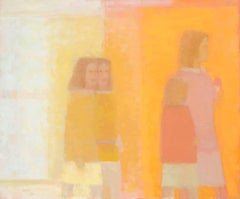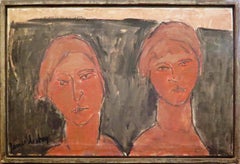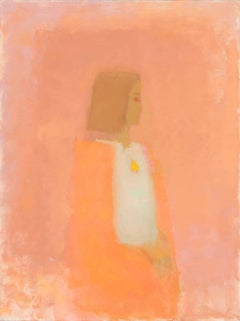American Modern Paintings
to
2
2
1
1
Overall Height
to
Overall Width
to
6
2
2
1
1
1
1
1
2
6
44
21
21
18
2
2
2
2
Style: American Modern
Artist: John Hartell
Open Door
By John Hartell
Located in Dallas, TX
Valley House Gallery is honored to present a selection of paintings from the estate of American artist, John Hartell (1902-1995). John Hartell taught two disciplines at Cornell University in Ithaca, New York: freshman architecture and graduate painting. He was a much-loved professor there from 1930 until his retirement in 1967; one of his most illustrious students is the architect Richard Meier. As an artist, Hartell's first solo exhibition was in 1937 at Kleeman Gallery in New York. He exhibited at Kraushaar Galleries in New York for four decades, beginning in 1943. The Hartell Gallery at Cornell University, under the Sibley Dome, is named for him. In describing John Hartell, the artist Michael Boyd...
Category
Late 20th Century American Modern Paintings
Materials
Canvas, Oil
School
By John Hartell
Located in Dallas, TX
Valley House Gallery is honored to present a selection of paintings from the estate of American artist, John Hartell (1902-1995). John Hartell taught two disciplines at Cornell University in Ithaca, New York: freshman architecture and graduate painting. He was a much-loved professor there from 1930 until his retirement in 1967; one of his most illustrious students is the architect Richard Meier. As an artist, Hartell's first solo exhibition was in 1937 at Kleeman Gallery in New York. He exhibited at Kraushaar Galleries in New York for four decades, beginning in 1943. The Hartell Gallery at Cornell University, under the Sibley Dome, is named for him. In describing John Hartell, the artist Michael Boyd...
Category
Late 20th Century American Modern Paintings
Materials
Canvas, Oil
Related Items
"Two Women"
By James Lechay
Located in Lambertville, NJ
James Lechay was a painter of figures, landscapes, cityscapes and still lifes who played a notable role in the tradition of avant-garde painting in New York and in the Midwest. An ar...
Category
20th Century American Modern Paintings
Materials
Canvas, Oil
Modern Abstracted Still-Life with Antique Coffee Grinder by Anthony Rappa
Located in Soquel, CA
Modern Abstracted Still-Life with Antique Coffee Grinder by Anthony Rappa
Modern textural still-life by California artist Anthony Rappa (America...
Category
1980s American Modern Paintings
Materials
Canvas, Oil, Cardboard
H 24 in W 30 in D 0.5 in
Riders of Pigeon Hill
By Jon Corbino
Located in Los Angeles, CA
Riders of Pigeon Hill, c. 1940s, oil on canvas, signed lower right, 24 x 36 inches, label verso with title, artist’s name and address; same information inscribed verso; ex-collection...
Category
1940s American Modern Paintings
Materials
Canvas, Oil
NYC Subway Mid 20th Century Modern American Scene Social Realism Contemporary
Located in New York, NY
NYC Subway Mid 20th Century Modern American Scene Social Realism Contemporary
David Atkins (1910 – 2012)
Subway Train Departure
24 x 30 inches
Oil on canvas, c. 1960s
Signed lower r...
Category
1960s American Modern Paintings
Materials
Canvas, Oil
The Artist's Wife oil painting by Hans Burkhardt
Located in Hudson, NY
Hans Burkhardt
The Artist's Wife (1930)
Oil on canvas, 20" x 16"
24" x 20 ½" x 1 ½" framed
Dated 1930 lower right recto. Annotated "To Elsa HB Louise Burkhardt 1930. HB" verso.
...
Category
1930s American Modern Paintings
Materials
Oil, Canvas
The Demogogue
Located in Los Angeles, CA
The Demagogue or Tale in a Tub, 1952, oil on canvas, 20 x 24 inches, signed, titled, and dated verso
About the Painting
The Demagogue is an iconic Bendor Mark painting from the prime of his post-war period. Beginning early in his career, Mark was fascinated with depictions of the human figure and their capacity to tell stories of the world around him. Mark was a keen observer of his times and in The Demagogue we see Mark’s portrayal of a faithless politician holding up a “V” for victory sign as he appeals to the wanton desires and prejudices of the masses. Below the demagogue is a swirl of humanity representing the common man who is being pushed down by the powerful, while the robed figure of liberty with her scales of justice held high is brushed aside. Behind the demagogue, Mark places two other powerful supporting institutions which were often co-opted by the world’s dictators, the Church and the Military. Mark was an internationalist, so it is difficult to know exactly which demagogue inspired him to create this work, but in 1952 there were many to choose from. Whether depicting Argentina’s Peron (the demagogue and the women to the right resemble Juan and Eva Peron), Spain’s Franco or the United States’ homegrown fear mongers like Joseph McCarthy, Mark tells a universal story that unfolded in dramatic fashion during the post-war period as nations and their peoples grappled with authoritarianism and anti-democratic impulses. Stylistically, The Demagogue draws on the elements which make Mark’s work from this period immediately recognizable, a saturated palette, a closely packed and frenetic composition, exaggerated figuration and stylized facial features. But, above all, we see Mark’s ability to tell the stories of the rich and powerful and their ability to oppress. Like Mark’s work in the collection of the Whitney Museum of American Art (The Hourglass - 1950-51) and the Los Angeles County Museum of Art (Execution – 1940), The Demagogue pulls no punches, as the artist lays bare the threats to freedom and basic human rights.
About the Artist
Bendor Mark was an American modernist and social realist painter. Born as Bernard Marcus on June 5, 1912, in Brooklyn, New York, Mark trained at The Cooper Union during the 1920s where he studied with William Brantley van Ingen and became a prize-winning artist with a focus on painting the human figure. After his time at Cooper, Mark continued to live in New York and worked as a commercial artist and textile designer in addition to his pursuit of a career in painting. Like many Depression Era artists, Mark engaged with social progressives and in 1934, he joined the Artist’s Union which had the goal of advancing artists’ position as “worker.” Mark’s painting, Restaurant, which is now in the permanent collection of the Smithsonian American Art Museum, appeared in the February 1936 edition of the Union’s publication, Art Front, as part of a review of an exhibition at ACA Gallery in New York.
Mark worked on the Federal Art Project and by the mid- to late-1930s, began a series of paintings exploring the working conditions and hazards of the mining industry. Mark believed that miners were “in the forefront of the struggle for emancipation” and that the mere “struggle for existence is like moving mountains.” He became passionate about the Spanish Civil War and painted sympathetic images in support of the Spanish Republic. Mark was a premature anti-fascist and throughout his career painted works critical of dictators and other oppressors. During the late 1930s, Mark entered mural competitions with designs influenced by the Mexican muralists, taught adult art education in Queens, New York, and was an instructor at the WPA’s Queensboro Art Center. He was so committed to socially progressive art that by 1934, he had changed his name to Bendor Mark, in part, to distinguish his social realist paintings from his earlier work.
During World War II, Mark worked as an artist for military contractors. After the war, he was employed as a graphic artist and in the printing industry before moving to Southern California in 1948, where he returned to a fine art practice the following year with politically and socially charged images which reflected his view of the shortcomings of the post-War period, the continued threat of fascism, and the international tensions of the Cold War. As the mood of the country shifted towards the right during the McCarthy Era and the art world’s attention focused on abstraction at the expense of figuration, Mark’s career as a painter suffered.
From the 1950s through the 1980s, Mark continued to depict the events that shaped the world around him, often employing a highly stylized approach characterized by dynamic multi-figure compositions, a subtle muted palette, and exaggerated expressive features. A review of Mark’s oeuvre suggests that few people escaped Mark’s attention. He painted presidents, prime ministers, royalty, evangelists, musicians, and dictators (and their henchman), along with miners, farm workers, the urban poor, protesters, the unemployed and dispossessed. He laid bare the arrogance, cruelty, and hypocrisy of the world’s elites. Mark noted, “A work of art cannot be fully appreciated or wholly understood without considering the socio-political and cultural ambience that gave it birth.” He continued, “I have the ability to foresee the direction of social and political events while they are actually taking place.” He was not himself a direct political activist, however. Although Mark commented, “It’s a misconception to separate art from the social aspect of life,” he viewed artists as being neutral. According to Mark, “An apolitical attitude reflects the fact that the artist is passive. . . An artist never affects society; he merely reflects it.”
In addition to the Mexican Muralists, Mark was influenced by the old masters Rembrandt, Michelangelo, and Masaccio, as well as the more modern master, Van Gogh. Mark’s writings directly acknowledge these influences and archival material from his estate includes magazine articles, pamphlets and transparencies related to these artists. Mark also collected materials related to several of his social realist contemporaries, including Reginald Marsh, Ben Shahn, Leonard Baskin, and Raphael Soyer, who was Mark’s good friend. For years, Soyer sent Mark holiday cards and Soyer inscribed a message of friendship on a self-portrait he gifted to Mark in the 1970s, all of which are still held in the collection of Mark’s family.
From the late 1920s through the mid-1950s, Mark’s work was well received. His paintings won prizes and were accepted into major juried exhibitions including at the Brooklyn Museum, the New York World’s Fair and the Metropolitan Museum of Art. He gained national recognition for paintings depicting the oppressed and the common worker. Despite the decline in popularity of representational art during the 1950s and 1960s, Mark stayed true to his interest in depicting the human figure and by the last two decades of his life, his work underwent a reassessment as curators included Mark’s paintings in exhibitions showcasing the role of labor in art during the Depression Era. This recognition continued in recent years when Mark was honored by having his work included in the Whitney Museum of American Art’s ground-breaking exhibition, Vida Americana, which explored the pioneering role that the Mexican muralists played in the development of modern American art during the inter-war period. The influence of Rivera, Siqueiros and Orozco on Mark is unmistakable and his paintings from the 1950s (and beyond) sit comfortably in dialogue with other Los Angeles artists who continued to paint in the social realist tradition long after the mainstream art world had moved toward abstraction. Mark’s concern for underserved Brown and Black communities was shared with artists such as Charles White and his ally, Edward Biberman...
Category
Mid-20th Century American Modern Paintings
Materials
Canvas, Oil
“Girl in the Grass”
Located in Southampton, NY
Original oil on canvas painting by Anton Refregier of a young girl resting in the grass. Signed upper right and dated 1962. Condition is very good. The painting is in its original oa...
Category
1960s American Modern Paintings
Materials
Oil, Canvas
Queen of the Night, narrative, partial nude figure, red colors, ethnic fabrics
Located in Brooklyn, NY
ABOUT the artist:
Audrey Frank Anastasi is a prolific feminist artist, working in painting, drawing, collage, mixed media, & printmaking. She is also curator, gallerist, educator and arts advocate. Most of Ms. Anastasi's figurative works are painted with her non-dominant left hand. She has created large bodies of works of birds, animals and birch trees.
She has had 20 solo & 200 group shows. Her "ref-u-gee" series will be shown in 2020 at Medgar Evers College in collaboration with the Valentine Museum of Art, Brooklyn. Accompanying the show will be a limited-edition monograph w/ over 180 images and a foreword by Phyllis Braff. Ms. Anastasi's collage series was exhibited at Welancora Gallery, Brooklyn, in May, 2019. In 2018, ten paintings were exhibited in "Painting to Survive," curated by Yale critic Jonathan Weinberg.
Book and catalog publications include "Stations of the Cross", SPQR press, BREUCKELEN magazine, “Audrey Frank Anastasi”, catalog essay Cindy Nemser, and "Collage," essay by Giancarlo T. Roma.
Public art includes a portrait of Jo Davidson...
Category
2010s American Modern Paintings
Materials
Canvas, Oil
mr. c and gladys, bright colorful man and dog
Located in Brooklyn, NY
*ABOUT Stephen Basso
Stephen Basso's highly original pastels and oil paintings are romantic, yet thought provoking fantasies. His whimsical works are alive with boundless imagina...
Category
2010s American Modern Paintings
Materials
Canvas, Oil
"Audience" Mid 20th Century American Figurative Theatre Performance Contemporary
By Leon Bibel
Located in New York, NY
"Audience" Mid 20th Century American Figurative Theatre Performance Contemporary
Leon Bibel (1912 - 1995) "The Audience," 52 ½ x 41 ¼ inches. Oil on canvas, c. 1963. Signed lower right. Framed.
BIO
Painter, printmaker and sculptor, Leon Bibel was born in San Francisco in 1913. He trained at the California School of Fine Arts and received a scholarship to study under the German Impressionist Maria Riedelstein. He worked in collaboration with Bernard Zackheim, a student of Diego Rivera, to create frescoes for the San Francisco Jewish Community Center and the University of California Medical School.
In 1936 Bibel moved from California to join the Federal Art Project at Harlem Art...
Category
1960s American Modern Paintings
Materials
Canvas, Oil
Modernist Floral Oil Painting Roses, Flowers in Vase WPA Artist Nicolai Cikovsky
Located in Surfside, FL
framed: 23 x 19.75
image: 15.5 x 11.5
Nicolai S. (Nicola) Cikovsky (1894 - 1984) was active/lived in New York / Russian Federation. Nicolai Cikovsky is known for Shore landscape, figure, still life and portrait painting, printmaking.
His mural "Irrigation," and "Gathering Dates" is at the Department of Interior, Washington, D.C. (WPA, GSA)
Landscape and figure painter Nicolai S. Cikovsky, 1894-1984, was born in Russia, where he studied at the Vilna Art School, 1910-1914; the Penza Royal Art School, 1914-1918; and Moscow High Tech Art...
Category
Mid-20th Century American Modern Paintings
Materials
Canvas, Oil
Ventian Courtyard
By Enid Smiley
Located in Buffalo, NY
An original oil on canvas by listed New York female artist Enid Smiley.
Category
1950s American Modern Paintings
Materials
Oil, Canvas
Previously Available Items
Vigil
By John Hartell
Located in Summit, NJ
American artist John Harrell (1902-1995) was an active painter for over sixty years. Much of his work can be described as impressionistic and abstract, however during a amperiod know...
Category
1960s American Modern Paintings
Stranger
By John Hartell
Located in Dallas, TX
Valley House Gallery is honored to present a selection of paintings from the estate of American artist, John Hartell (1902-1995). John Hartell taught two disciplines at Cornell Unive...
Category
Late 20th Century American Modern Paintings
Materials
Canvas, Oil
Dune Road
By John Hartell
Located in Dallas, TX
Valley House Gallery is honored to present a selection of paintings from the estate of American artist, John Hartell (1902-1995). John Hartell taught two disciplines at Cornell Unive...
Category
1980s American Modern Paintings
Materials
Canvas, Oil
American Modern paintings for sale on 1stDibs.
Find a wide variety of authentic American Modern paintings available for sale on 1stDibs. Works in this style were very popular during the 21st Century and Contemporary, but contemporary artists have continued to produce works inspired by this movement. If you’re looking to add paintings created in this style to introduce contrast in an otherwise neutral space in your home, the works available on 1stDibs include elements of blue, orange, purple, red and other colors. Many Pop art paintings were created by popular artists on 1stDibs, including Clarence Holbrook Carter, Donald Stacy, Patricia Gren Hayes, and Jack Hooper. Frequently made by artists working with Paint, and Oil Paint and other materials, all of these pieces for sale are unique and have attracted attention over the years. Not every interior allows for large American Modern paintings, so small editions measuring 2 inches across are also available.
Recently Viewed
View AllMore Ways To Browse
Advertising Box
Great Race
House And Garden Book Of
Fells House
C Raymond
Religious Icon
W S George
Candy Pink
Early 19th Century Portrait French
Large Baroque Painting
Original Painting Book Cover
Oriental Vintage Painting
Mary Child
Child Mary
Tiger Canvas
Used Book Search
Religious Paintings On Wood
Constant George




